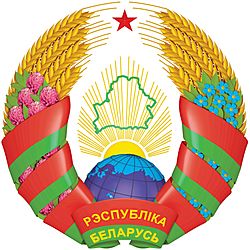National emblem of Belarus facts for kids
Quick facts for kids National Emblem of Belarus |
|
|---|---|
 |
|
| Armiger | Republic of Belarus |
| Adopted | June 7, 1995 |
| Crest | Red star |
| Blazon | Globe, rising sun and a outline of Belarus in green |
The national emblem of Belarus is an important symbol of the country. It shows what Belarus stands for. This emblem was chosen in 1995. It replaced an older symbol called the Pahonia arms.
The emblem has a special ribbon with the colors of the national flag. It also shows a map of Belarus, ears of wheat, and a red star. While some people call it the "coat of arms" of Belarus, it is officially known as the national emblem.
Contents
What is the National Emblem of Belarus?
A national emblem is a special design that represents a country. It is like a visual signature for the nation. The national emblem of Belarus tells a story about its land, people, and hopes for the future. It is a modern symbol, adopted after Belarus became an independent country.
What Does the Emblem Look Like?
The emblem of Belarus is round. It has a green outline of the country in the center. Behind this map, you can see a golden sun rising. This sun shines its rays over a globe, which shows part of the Earth.
The whole design is framed by a wreath. This wreath is made of golden wheat ears. On the left side, the wheat is mixed with clover flowers. On the right side, it has flax flowers. At the very top of the emblem, there is a red five-pointed star. A ribbon in the colors of the Belarusian flag (red and green) wraps around the wreath.
Symbols and Their Meanings
Each part of the national emblem has a special meaning:
- The green outline of Belarus shows the country's borders. It reminds people of their homeland.
- The rising sun stands for a new beginning and a bright future. It also represents life and energy.
- The globe shows that Belarus is part of the world. It means the country wants to live in peace with other nations.
- The wheat ears symbolize harvest, wealth, and hard work. They represent the farming traditions of Belarus.
- The clover and flax flowers are traditional plants of Belarus. They show the country's nature and its rich agriculture.
- The red star is a symbol of protection and freedom. It has been used in Belarus for a long time.
How the Emblem Changed Over Time
Before 1995, Belarus used a different national symbol. This older symbol was called the Pahonia. It had a long history.
The Pahonia Emblem
The Pahonia (which means "pursuit" or "chase") was the traditional coat of arms for centuries. It showed a knight on a white horse, holding a sword and a shield. This knight was often seen as a symbol of bravery and defense. The Pahonia was used by the Grand Duchy of Lithuania, which included much of modern Belarus. It was also the state symbol of Belarus from 1991 to 1995.
Why the Emblem Changed in 1995
In 1995, Belarus held a national vote, called a referendum. People voted on several important issues. One of these was about the national symbols. The majority of people voted to change the flag and the emblem. This led to the adoption of the current national emblem on June 7, 1995. The new emblem was designed to be more modern and to represent the country's new path.
Where You Can See the Emblem Today
The national emblem is used on many official items in Belarus. You can see it on:
- Belarusian passports and other official documents.
- Government buildings, like the National Bank.
- Money, such as banknotes and coins.
- Official stamps and awards.
- It is a proud symbol displayed during national holidays and events.
Images for kids
-
“Coats of arms of Belarusian voivodeships”, a postcard printed by the Belarusian Democratic Republic
-
Pahonia on a printed leaflet of Belarusian exiles in 1948, dedicated to the 30th anniversary of the Belarusian Democratic Republic
-
Belarusian monument in South River, New Jersey with a Pahonia on it
-
1 Belarusian ruble bill, 1992
See also
 In Spanish: Emblema de Bielorrusia para niños
In Spanish: Emblema de Bielorrusia para niños





































